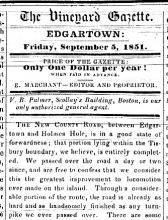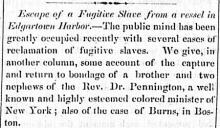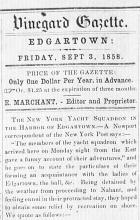When Edgartown residents voted on secession 51 years ago, they were 100 to one against it.
They even voted $1,000 to stop it.
They were on the other side of the stick then. Pending in the General Court at the time was a bill which would have allowed Chappaquiddick to secede from Edgartown and become an independent municipality.
It started over a bridge. It didn’t go far. The anti-secession vote was taken on Feb. 23, 1926. On April 8 of that year, 11 members of the joint committee on towns came to the Island for an evening hearing at the town hall. About a week later the committee voted to allow the petitioners to withdraw the bill - a polite way of saying “no dice.”
The committee had before it requests from several other communities in the Commonwealth, all wanting to be separated from their ruling towns.
But the Chappaquiddick request was unusual. The proposed bill provided for the proportionment of county tax; for establishment of new debt ceilings for the two towns; for allocation of the “costs for the support and relief of those persons now or hereafter needing support or relief as paupers”; and sundry other necessaries.
The next to last section bears repeating in full. (The last section made the act effective immediately on passage.)
“Not withstanding the passage of this act, residents of the town of Edgartown shall have the same rights as to fishing in the waters of the town of Chappaquiddick as the citizens of Chappaquiddick, subject, however, to the bylaws of said town,” it said.
The importance of the clause was made clear to the committee at that April 8 hearing. Benjamin G. Collins, of Edgartown, speaking against the proposal, told the Chappaquiddickers, “If it wasn’t for the $100,000 yearly shellfish catch the grounds of which are mostly in Chappaquiddick waters, I would say ‘Go and God Bless you.’”
To which William J. Miller, attorney for the Chappaquiddickers, “Take the fisheries; we’ll take you at your offer. But give us our separation!”
Two and a half years before, in the fall of 1923, the newly formed Chappaquiddick Association wrote an open letter to the Edgartown selectmen asking that the town lay out a way from the Katama Road to the Swimming Place on the Edgartown Harbor, and then to build a bridge across to the little Island. It would have come ashore on Chappaquiddick just south of the mouth of Caleb’s Pond.
It was the obvious spot for a bridge. Aside from the stretch between Chappaquiddick Point and the present-day Memorial Wharf, it is the narrowest place in the harbor - it is 600 feet from shore to shore.
Furthermore, the high bank on the Edgartown side made the bridge approaches simple at the end at least.
The request was duly put before the voters at an annual town meeting on Feb. 25, 1924. Instead of approving the layout and bridge, the voters appointed a committee of Richard L. Colter, Benjamin W. Pease and Benjamin G. Collins to look into the matter and report back “at some future time.”
Mr. Pease owned property on Chappaquiddick. He evidently wasn’t satisfied with the activity of his fellow committee members. That summer, he and the other members of the Chappaquiddick Association retained Irving Austin Ventres, an engineering consultant, to make a study of the problem.
Mr. Ventres reported that a tunnel would cost $500,000, and would be difficult to pump out and ventilate. Further, he said, “there would be great danger of people walking or riding in exposed vehicles through the tunnel of taking cold or sickness.” He also looked into a chain ferry, but that had difficulties. The association noted that “24-hour service will require two men, if not more, who are strong, healthy, who will not become intoxicated or sick, and will attend without failure to their duties...”
The answer, Mr. Ventres concluded, is a bridge. And he asked the American Bridge Company to design one.
They did. The bridge was to be “three steel spans, 208 feet long each, the center span 59 feet above water - the shore span 8 feet lower, being a 4 per cent grade at each end, resting on concrete foundations of two piers 50 feet above the water and two bulkheads 42 feet above the water level - cement slab roadway two feet wide - ten-ton roller bridge equipped to carry installations for water, gas, electricity and telephone wires and for electric lights.”
The total cost was to be no more than $100,000, including the necessary ramps and retaining wall stone work. The bridge was to be a “so-called permanent improvement” which would last for 400 years, at an annual maintenance cost of $200.
In January, 1925, the Chappaquiddick Association promulgated another open letter, this one addressed to all the residents of Edgartown, asking them for their support, or at least, for the opportunity to rectify any misimpressions from which they might be suffering.
The letter said, in tiny part: “Extreme need of the bridge includes the moral issue which is to save the residents of Chappaquiddick from death, help them in sickness, make it possible for doctors to get to the sick, make possible the obtaining of needed supplies, personal safety and freedom from damage, injury and exposure due to the lack of protection or facilities in the winter season, and relief from the extreme physical effort now necessary.”
“If the steamboat service to Martha’s Vineyard were discontinued and the residents had to use their motorboats and sail craft to supply their needs, they would be in the present position of the residents of Chappaquiddick in supplying their needs,” it continued.
But that was the smallest part of it. The bulk of it foreshadowed Mr. Miller’s remarks about the fisheries of the following year.
“The taxes on the increased value of the Island of Chappaquiddick will equal the cost of the bridge,” the letter said. The association argued that land on Chappaquiddick was practically without value, because the cost of living on the little island was 25 per cent higher than on the main land. With a bridge, however, the land would rise to be equal in value with the rest of Edgartown.
At the time, the taxed value of Chappaquiddick was $250,000. Upon construction of an adequate bridge, that value would rise to $2 or $3 million, it said. That would increase tax revenues of the town enough to pay $5,000 per year for bonds due, and $4,000 per year for interest. The interest cost would quickly fall. By 1945, the entire $100,000 bond issue would be retired.
And all this at no increased cost to Chappaquiddickers, because the increase in taxes would be offset by a decrease in standard of living.
The effectiveness of the letter was tested on Feb. 24 of that year, 1925. An article directing the town to build the bridge was indefinitely postponed by a vote of 99-58.
Part of the reason for that vote was that the town had recently undertaken a $100,000 bond issue to finance the Union School building, and was feeling that burden.
But there was also some sentiment that the Chappaquiddick forces behind the bridge more motivated by more selfish reasons than they were admitting - the bridge would be a land speculator’s dream, they hoped.
So the next year Edgartown’s voters were asked to “See what action the town would take relative to House Bill 254 (pertaining to the separation of the Island of Chappaquiddick from the town of Edgartown).
The action they took was as graceful as their reaction to Cottage City’s proposal to leave Edgartown 50 years before: they voted $1,000 to hire legal counsel to “defend the town’s interest.”
It was all over then but the fireworks. The legislative committee was treated to that when it visited the Island in April of that year.
The proponents argued that the town was neglecting them, that they were not being provided with adequate police or fire protection, nor adequate schools and roads.
Among the opponents, Mr. Collins said the effort was “merely an attempt to blackjack the town into paying $200,000 or $300,000 for the benefit of real estate speculators,” and named Charles M. Ide in particular. Mr. Ide, who was a beneficiary of the trust which owned Chappaquiddick by the Sea, “got hooked in real estate speculation and now he’s trying hard to get rid of his holdings,” Mr. Collins said,
William M. Noble, attorney for the opponents, said that James A. Jeremiah of New York and Chappaquiddick was attempting to form a private corporation of the new town.
The opponents clearly had the numbers on their side. There were only 50 or so houses on Chappaquiddick at the time, and only a few of those were occupied in the winter - partly because when the schoolhouse on Chappaquiddick closed in 1916, families with children moved to the main Island. When the committee asked for a straw vote of the people at the hearing, two-thirds said no to the formation of what might have been Martha’s Vineyard’s seventh town.









Comments